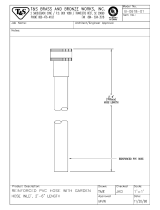
Page 19
FRANÇAIS
Polaris
®
Pompe de surpression PB4SQ™
|
Manuel d'installation et mode d'emploi
LIRE ET SUIVRE TOUTES LES INSTRUCTIONS
Section 1. CONSIGNES DE SÉCURITÉ IMPORTANTES
Tous les travaux électriques doivent être effectués par un électricien agréé et doivent être conformes aux normes
fédérales, provinciales et locales. Lorsque vous installez et utilisez cet équipement électrique, des mesures de sécurité
de base doivent toujours être prises, en particulier les mesures suivantes :
AVERTISSEMENT
Pour réduire le risque de blessure, ne laissez pas les enfants
utiliser ce produit.
Pour réduire le risque de dommage matériel ou de blessure, ne
tentez pas de changer la position de la valve de lavage à contre-
courant (multivoies, glissement ou débit intégral) pendant le
fonctionnement de la pompe.
Les pompes Polaris fonctionnent à l'aide d'un moteur électrique
haute tension et doivent être installées par un électricien certié
ou autorisé, ou un technicien qualié en entretien et en réparation
de piscines.
AVERTISSEMENT
RISQUE DE CHOC ÉLECTRIQUE, D'INCENDIE, DE
BLESSURES OU DE MORT. Branchez l'appareil uniquement à un
circuit qui est protégé par un disjoncteur de fuite de terre (DDFT).
Communiquez avec un électricien qualié si vous ne pouvez pas
conrmer que le circuit est protégé par un disjoncteur de fuite de
terre. Assurez-vous que ce disjoncteur de fuite de terre soit fourni
par l'installateur et testé régulièrement. Pour tester le disjoncteur
de fuite de terre, appuyez sur le bouton de test. Le disjoncteur de
fuite de terre doit interrompre l'alimentation électrique. Appuyez
sur le bouton de réinitialisation. L'alimentation électrique devrait
être rétablie. Si le disjoncteur de fuite de terre ne fonctionne pas
de cette façon, le disjoncteur est défectueux. Si le disjoncteur
de fuite de terre interrompt l'alimentation de la pompe sans que
vous enfonciez le bouton de test, cela signie qu'un courant à la
terre circule et qu'un choc électrique est possible. N'utilisez pas la
pompe. Débranchez la pompe, puis faites corriger le problème par
un représentant d'entretien qualié avant de l'utiliser.
En raison du risque potentiel d'incendie, de choc électrique ou de
blessures corporelles, les pompes Polaris doivent être installées
conformément au code électrique national (National Electrical
Code
®
– NEC
®
), à tous les codes d'électricité et de sécurité locaux,
ainsi qu'à la Loi de sécurité et de salubrité du travail (OSHA
®
).
Vous pouvez obtenir des exemplaires du code électrique national
de l'association nationale de protection contre l'incendie (National
Fire Protection Association
®
– NFPA
®
) en ligne au www.nfpa.org ou
en composant le 617-770-3000 ou en communiquant avec votre
organisme d'inspection gouvernemental local.
Un équipement installé incorrectement peut être défaillant et
causer des blessures graves ou des dommages matériels.
AVERTISSEMENT
• Ne raccordez pas le système à un système d'alimentation en
eau urbain non règlementé ou à une autre source externe d'eau
sous pression générant des pressions supérieures à 35 psi.
• Un équipement installé incorrectement peut être défaillant et
causer des blessures graves ou des dommages matériels.
• L'air emprisonné dans le système risque de provoquer une
ouverture explosive du couvercle du ltre, ce qui peut entraîner
la mort, des blessures graves ou des dommages matériels. Avant
d'utiliser le système, assurez-vous que tout l'air soit expulsé.
Pour réduire les risques de blessures graves ou mortelles, le ltre
et/ou la pompe ne doivent pas être soumis à l'essai de mise sous
pression du système de tuyauterie.
Les codes locaux peuvent exiger un essai de mise sous pression
du système de tuyauterie de la piscine. Ces exigences ne
s'appliquent généralement pas aux équipements de piscine tels
que les ltres ou les pompes.
L'équipement de piscine Polaris a fait l'objet d'un essai de mise
sous pression en usine.
Toutefois, si l'AVERTISSEMENT ne peut pas être respecté et que
l'essai de mise sous pression du système de tuyauterie doit inclure
le ltre et/ou la pompe, ASSUREZ-VOUS DE VOUS CONFORMER
AUX CONSIGNES DE SÉCURITÉ SUIVANTES :
Vériez que l'ensemble des brides, boulons, couvercles, bagues de
retenue et accessoires du système sont correctement installés et
xés avant d'effectuer un essai.
ÉVACUEZ TOUT L'AIR du système avant d'effectuer un essai.
La pression d'eau pour l'essai ne doit PAS DÉPASSER 35 PSI.
La température de l'eau pour l'essai ne doit PAS DÉPASSER
100 °F (38 °C).
Limitez l'essai à 24 heures. Après l'essai, vériez visuellement le
système pour vous assurer qu'il est prêt à fonctionner.
AVIS : Ces paramètres s'appliquent uniquement à l'équipement
Polaris. Pour un équipement qui n'est pas fabriqué par Polaris,
consultez le fabricant.
Des déversements et vapeurs chimiques peuvent affaiblir
l'équipement de la piscine/du spa. La corrosion risque de
provoquer la défaillance des ltres et autres équipements, ce qui
peut entraîner des blessures graves ou des dommages matériels.
N'entreposez pas de produits chimiques pour piscine à proximité
de votre équipement.
ATTENTION
Ne démarrez pas la pompe à sec! Faire fonctionner la pompe à sec
pendant une durée quelconque causera des dommages importants
et annulera la garantie.
Cette pompe doit être utilisée avec des piscines installées de
manière permanente et, si cela est également mentionné, avec des
cuves thermales et des spas. Ne l'utilisez pas avec des piscines
remisables. Une piscine permanente est construite dans le sol,
sur le sol ou dans un bâtiment et ne peut pas être facilement
démontée et entreposée. Une piscine remisable est conçue pour
être facilement démontée et entreposée, puis remontée dans son
état initial.
Ne l'installez pas dans une enceinte extérieure ou sous les bords
d'une cuve thermale ou d'un spa portatif. La pompe nécessite
une ventilation adéquate an de maintenir la température de l'air
inférieure à la température ambiante maximale indiquée sur la
plaque signalétique du moteur.
CONSERVEZ CES INSTRUCTIONS




















